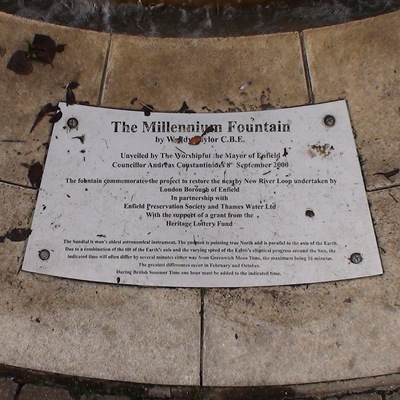Erection date: 2014
{Plaque on the front of the plinth, beneath a drawing of a lion:}
The lion was the emblem for the British Empire Exhibition in 1924 - 1925. This lion head was a decorative flag pole support from the Palace of Industry.
Presented in 2014 for the 90th anniversary of the British Empire Exhibition.
Brent, Wembley Park
{Information panel on the side of the plinth:}
The lion head came from a building that was part of the British Empire Exhibition, opened on 23 April 1924 by King George V. People from fifty-six British governed countries across the world came to Wembley Park, to encourage trade and to get to know each other better.
Many exhibition buildings, including the stadium, were designed by the architect Maxwell Ayrton and the engineer Sir Owen Williams. Work began in 1922, using the relatively new material reinforced concrete. By using liquid concrete, decorative shapes such as the lion head could be cast in their designs.
Where you are standing is marked in blue on this original map of the exhibition. Today Brent Civic Centre occupies part of the Palace of Industry site, and the large arrow would now point to Wembley Library. More than 17 million people came to the exhibition in 1924, with another 10 million visitors to Wembley when it reopened in 1925.
Many of the original pavilions at the exhibition were designed in the architectural styles of their countries. India (pictured) had tall minarets, while Burma's buildings were decorated with carved teak wood. West Africa's walled city had a village of thatched huts inside, where craftsmen showed their skills. Hong Kong built a complete Chinese street, with traders selling silk and toys.
The exhibition also had huge buildings showing off the arts, engineering and industry of Britain itself. This photo shows the Palace of Industry, looking up what is now Olympic Way towards the stadium, where spectacular shows were put on. Each of the flag poles along the Palace of Industry's sides was supported by a lion head.
Some buildings were demolished soon after the exhibition ended. The stadium survived until 2002, and became the "Venue of Legends". It was also home to the Wembley Lions speedway team. The last exhibition building, part of the Palace of Industry, came down in 2013. Several of the lion heads were carefully saved, so that you can enjoy seeing a "Wembley Lion" here today.
Site: Wembley Lion (1 memorial)
HA9, Wembley Hill Road
Credit for this entry to: Alan Patient of plaquesoflondon.co.uk


















Comments are provided by Facebook, please ensure you are signed in here to see them